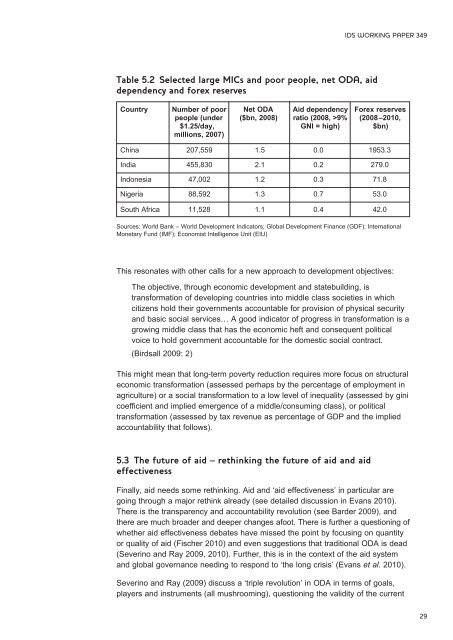Andy Sumner - Institute of Development Studies
Andy Sumner - Institute of Development Studies
Andy Sumner - Institute of Development Studies
Create successful ePaper yourself
Turn your PDF publications into a flip-book with our unique Google optimized e-Paper software.
IDS WORKING PAPER 349Table 5.2 Selected large MICs and poor people, net ODA, aiddependency and forex reservesCountry Number <strong>of</strong> poor Net ODA Aid dependency Forex reservespeople (under ($bn, 2008) ratio (2008, >9% (2008–2010,$1.25/day, GNI = high) $bn)millions, 2007)China 207,559 1.5 0.0 1953.3India 455,830 2.1 0.2 279.0Indonesia 47,002 1.2 0.3 71.8Nigeria 88,592 1.3 0.7 53.0South Africa 11,528 1.1 0.4 42.0Sources: World Bank – World <strong>Development</strong> Indicators; Global <strong>Development</strong> Finance (GDF); InternationalMonetary Fund (IMF); Economist Intelligence Unit (EIU)This resonates with other calls for a new approach to development objectives:The objective, through economic development and statebuilding, istransformation <strong>of</strong> developing countries into middle class societies in whichcitizens hold their governments accountable for provision <strong>of</strong> physical securityand basic social services… A good indicator <strong>of</strong> progress in transformation is agrowing middle class that has the economic heft and consequent politicalvoice to hold government accountable for the domestic social contract.(Birdsall 2009: 2)This might mean that long-term poverty reduction requires more focus on structuraleconomic transformation (assessed perhaps by the percentage <strong>of</strong> employment inagriculture) or a social transformation to a low level <strong>of</strong> inequality (assessed by ginicoefficient and implied emergence <strong>of</strong> a middle/consuming class), or politicaltransformation (assessed by tax revenue as percentage <strong>of</strong> GDP and the impliedaccountability that follows).5.3 The future <strong>of</strong> aid – rethinking the future <strong>of</strong> aid and aideffectivenessFinally, aid needs some rethinking. Aid and ‘aid effectiveness’ in particular aregoing through a major rethink already (see detailed discussion in Evans 2010).There is the transparency and accountability revolution (see Barder 2009), andthere are much broader and deeper changes afoot. There is further a questioning <strong>of</strong>whether aid effectiveness debates have missed the point by focusing on quantityor quality <strong>of</strong> aid (Fischer 2010) and even suggestions that traditional ODA is dead(Severino and Ray 2009, 2010). Further, this is in the context <strong>of</strong> the aid systemand global governance needing to respond to ‘the long crisis’ (Evans et al. 2010).Severino and Ray (2009) discuss a ‘triple revolution’ in ODA in terms <strong>of</strong> goals,players and instruments (all mushrooming), questioning the validity <strong>of</strong> the current29
















